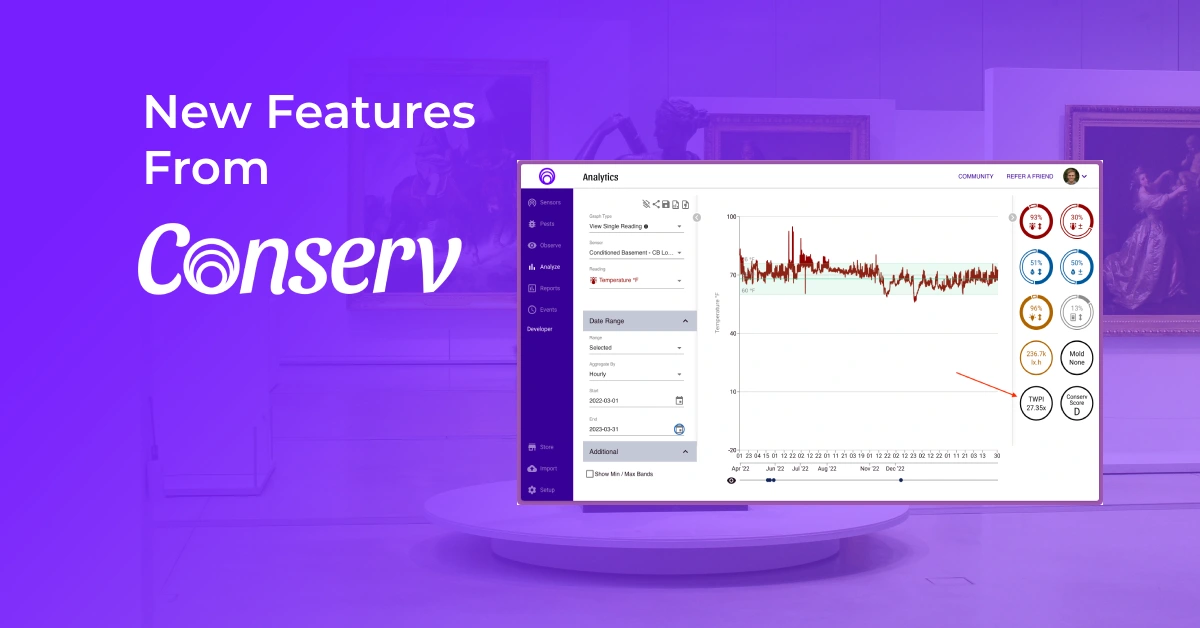At Conserv, we are always updating our platform to meet your expectations and needs. We want you to be able to manage your collections with confidence, using bespoke tools that have been designed to make your work easier. This is why, after listening to your concerns and requests, we are replacing the Relative Damage Ratio performance indicator in Conserv Cloud with the Time-Weighted Preservation Index (TWPI) to align with industry standards.
So what does this change mean? Let’s take a look at the feature changes and where you will be able to find them in the platform:
Key Performance indicators in Conserv Cloud
Conserv has developed seven metrics to help guide you on your journey to better environmental monitoring for your collection:
- % of time within your set desirable ranges for temperature, relative humidity and light levels
- % of time within maximum fluctuation levels for temperature and relative humidity
- Conserv score to rate your temperature and relative humidity fluctuations
- Mold risk score to indicate the possibility of mold growth
- Lux hours for the total dose of light exposure
- Pest Occurrence Index (POI) by Jane Henderson and Christian Baars to normalize your pest count data.
- Relative Damage Ratio to assess speed of deterioration over time, based on Tim Padfield’s approach.
What is the Relative Damage Ratio?
The purpose of damage rate calculations is to link environmental conditions with the rate of deterioration in materials. The Conserv Relative Damage Ratio did this by comparing your actual environmental measurements to the ideal standards you set in the software.
Whenever your environmental standards differed from your ideal, this would be interpreted as a % and a multiplication factor. So if you went over your target points by about 20%, your Relative Damage Rate would say your collection may be deteriorating 1.2x faster than if you had met your environmental targets.
What is the Time-Weighted Preservation Index?
The Time-Weighted Preservation Index, or TWPI, developed by the Image Permanence Institute, is a number that indicates how many years your collection is meant to last given the current environmental conditions it is in. This calculation is based on extensive testing of the hydrolysis reactions of cellulose acetate, which is a notoriously delicate material. As the TWPI unit is years, generally speaking, the higher your TWPI, the longer your collections are likely to last.
Why are we changing from the Damage Ratio to the TWPI?
One of Conserv’s main values is to create a common language for monitoring at your organization. After conversations with thousands of professionals in charge of collections care and many requests to compare the Relative Damage Rate to the TWPI, we have decided to switch our damage rate calculation to the TWPI. We recognize that the TWPI is an industry standard which many of us use in our reports and goal-setting, so we are happy to incorporate this calculation into our software.
Where will you find the TWPI on Conserv Cloud?
You will find your TWPI number (in years) on the right side bar, to the left of the Conserv Score.
We are always looking for feedback
Today, over 300 museums, libraries, archives and historic properties are monitoring their collection environments with Conserv, and we are committed to providing you with tools that are designed with you in mind.
Is there any other issue you’d like to share with us? Any other changes or improvements you’d like to see? Fill in our survey today and let us know. We are listening.
If you have any questions about environmental monitoring, integrated pest management, or just want to talk about preventative conservation, please reach out to us! Don’t forget to check out our blog or join our community of collections care professionals where you can discuss hot topics, connect with your peers or even take a course to get familiar with the Conserv platform.





